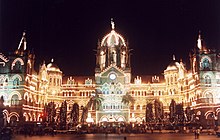Colonial Era (1857 CE—1947 CE)

European colonialism bought with it a wide array of influences to further shape Indian architecture. Imperial power was stressed by using grand buildings. Local craftsmen incorporated new skills and added them to their trade. Colonial architecture became assimilated into India's diverse traditions. Other innovations made during the European Industrial Revolution came with the British Raj to India.
The European involvement in India through the 1920s and the 1930s brought architect Le Corbusier and the Art Deco movement to India. Fusion has been a consistent feature of modern Indian architecture—for example Indian elements of chhajja (wide roof overhangs), jaali (circular stone apertures) and chhatri (free-standing pavilions) were intermixed with European architecture during the construction of the Rastrapati bhavan.[33] This neoclassical project—which also contained a stupa like dome—was overseen by Sir Edwin Landseer Lutyens and the Indian Institute of Architects (est. 1917).
source:wikipedia
No comments:
Post a Comment